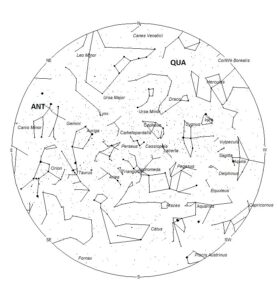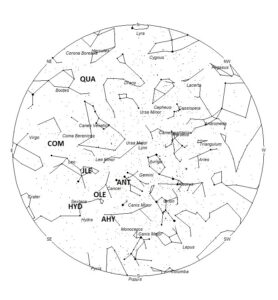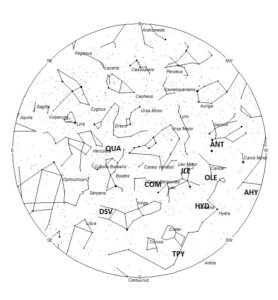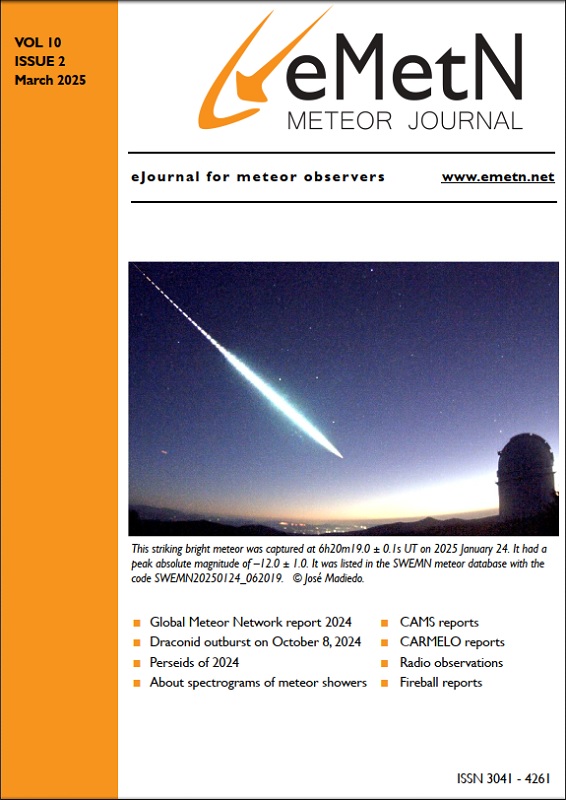During this period, the moon reaches its first quarter phase on Tuesday January 7th. At that time the moon will be located 90 degrees east of the sun and will set near midnight local standard time (LST). This weekend the waxing crescent moon will set during the evening hours and will not interfere with meteor observations during the more active morning hours. The estimated total hourly rates for evening observers this weekend should be near 4 as seen from mid-northern latitudes (45N) and 3 as seen from tropical southern locations (25S). For morning observers, the estimated total hourly rates should be near 17 as seen from mid-northern latitudes (45N) and 13 as seen from tropical southern locations (25S). The actual rates seen will also depend on factors such as personal light and motion perception, local weather conditions, alertness, and experience in watching meteor activity. Evening rates are slightly reduced due to moonlight. Note that the hourly rates listed below are estimates as viewed from dark sky sites away from urban light sources. Observers viewing from urban areas will see less activity as only the brighter meteors will be visible from such locations.
The radiant (the area of the sky where meteors appear to shoot from) positions and rates listed below are exact for Saturday night/Sunday morning January 4/5. These positions do not change greatly day to day so the listed coordinates may be used during this entire period. Most star atlases (available online and at bookstores and planetariums) will provide maps with grid lines of the celestial coordinates so that you may find out exactly where these positions are located in the sky. I have also included charts of the sky that display the radiant positions for evening, midnight, and morning. The center of each chart is the sky directly overhead at the appropriate hour. These charts are oriented for facing south but can be used for any direction by rotating the charts to the desired direction. A planisphere or computer planetarium program is also useful in showing the sky at any time of night on any date of the year. Activity from each radiant is best seen when it is positioned highest in the sky, either due north or south along the meridian, depending on your latitude. Radiants that rise after midnight will not reach their highest point in the sky until daylight. For these radiants, it is best to view them during the last few hours before dawn. It must be remembered that meteor activity is rarely seen at its radiant position. Rather they shoot outwards from the radiant, so it is best to center your field of view so that the radiant lies toward the edge and not the center. Viewing there will allow you to easily trace the path of each meteor back to the radiant (if it is a shower member) or in another direction if it is sporadic. Meteor activity is not seen from radiants that are located far below the horizon. The positions below are listed in a west to east manner in order of right ascension (celestial longitude). The positions listed first are located further west therefore are accessible earlier in the night while those listed further down the list rise later in the night.

Radiant Positions at 18:00 Local Standard Time

Radiant Positions at Midnight Local Standard Time

Radiant Positions at 06:00 Local Standard Time
These sources of meteoric activity are expected to be active this week
.
Now that the activity from particles produced by comet 2P/Encke have ceased encountering the Earth, the Taurid showers for 2024 are over and we resume reporting activity from the Anthelion (ANT) radiant. This is not a true radiant, but rather activity caused by the Earth’s motion through space. As the Earth revolves around the sun it encounters particles orbiting in a pro-grade motion that are approaching their perihelion point. They all appear to be radiating from an area near the opposition point of the sun, hence the name Anthelion. These were once recorded as separate showers throughout the year, but it is now suggested to bin them into a category separate from true showers and sporadics. This radiant is a very large oval some thirty degrees wide by fifteen degrees high. Activity from this radiant can appear from more than one constellation. The position listed here is for the center of the radiant which is currently located at 07:48 (117) +21. This position lies in eastern Gemini, 8 degrees south of the 1st magnitude star known as Pollux (beta Geminorum). This radiant is best placed near 01:00 local standard time (LST) when it lies on the meridian and is highest in the southern sky. Rates at this time should be near 3 per hour as seen from the northern hemisphere and 2 per hour as seen from south of the equator. With an entry velocity of 30 km/sec., the average Anthelion meteor would be of slow velocity.
The alpha Hydrids (AHY) were discovered by Dr. Peter Brown and are mentioned in his article “A meteoroid stream survey using the Canadian Meteor Orbit Radar”. This shower is active from December 15 through January 22 with maximum activity occurring on January 5th. The radiant is currently located at 08:32 (128) -08. This position lies in western Hydra, 12 degrees west of the 2nd magnitude star known as Alphard (alpha Hydrae). These meteors are best seen near 0200 LST when the radiant lies highest above the southern horizon. At 43 km/sec. the alpha Hydrids produce meteors of medium velocity. Expected rates this week are near 1 per hour no matter your location.
The omicron Leonids (OLE) were discovered by Damir Šegon and the Croatian Meteor Network team based on studying SonotaCo and CMN observations (SonotaCo 2007-2011, CMN 2007-2010). These meteors are active from December 20 through January 22. Maximum activity occurs on January 8th. The radiant is currently located at 08:56 (134) +10. This position lies in southeastern Cancer, 2 degrees south of the 4th magnitude star known as Acubens (alpha Cancri). These meteors are best seen near 0200 LST when the radiant lies highest above the southern horizon. At 41 km/sec. the omicron Leonids produce meteors of medium velocity. Expected rates this week are less than 1 per hour no matter your location. These meteors are also known as the kappa Cancrids.
The last of the sigma Hydrids (HYD) are expected this week from a radiant located at 09:32 (143) -03. This area of the sky is located in western Hydra, 5 degrees northeast of the 2nd magnitude star known as Alphard (alpha hydrae). These meteors are active from November 24 through January 7th, with the main maximum activity occurring on December 7th. To best see these meteors, face toward the south during the last couple of hours prior to dawn. With an entry velocity of 56km/sec, most of these meteors would appear swift. Expect to see less than 1 per hour no matter your location.
The January Leonids (JLE) were discovered by Dr. Peter Brown and are mentioned in the same publication as the Alpha Hydrids. This shower is active from December 28 through January 07 with maximum activity occurring on January 2nd. The radiant is currently located at 09:58 (150) +23. This position lies in northwestern Leo, 3 degrees southeast of the 3rd magnitude star known as Algenubi (epsilon Leonis). These meteors are best seen near 0300 LST when the radiant lies highest above the southern horizon. At 52 km/sec. the January Leonids produce meteors of medium-swift velocity. Expected rates this week less than 1 no matter your location.
The kappa Velids (KVE) were recently discovered by SAAMER (Pokorný et al., 2017), an Argentine meteor radar system. This radiant is the main radiant in an area where many minor radiants seem to be active this time of year. The KVE’s are active from December 16 through January 6 with maximum activity occurring on December 26th. The radiant is currently located at 10:05 (151) -54, which places it in southern Vela, 1 degree northeast of the 4th magnitude star known as phi Velorum. These meteors are best seen near 0300 LST when the radiant lies highest above the southern horizon. Current rates should be near 1 per hour as seen from the southern hemisphere and less than 1 as seen from north of the equator. With an entry velocity of 43 km/sec., most activity from this radiant would be of medium speed.
The theta Pyxidids (TPY) consists of two weak showers that peak two weeks apart. The later version is active from December 8 through January 8, with maximum occurring on December 18th. The radiant is currently located at 11:32 (173) -29. This area of the sky is located in eastern Hydra, 3 degrees north of the 4th magnitude star known as xi Hydrae. These meteors are best seen near 0500 LST when the radiant lies highest in the southern sky. Rates are expected to be less than 1 no matter your location. At 65 km/sec. the theta Pyxids would produce mostly swift meteors.
The Comae Berenicids (COM) are a long duration shower active from December 5th through February 4th. Maximum activity occurred on December 16th. The radiant is currently located at 11:45 (176) +23, which places it in northeastern Leo, 8 degrees north of the 2nd magnitude star known as Denebola (beta Leonis). These meteors would be best seen near 05:00 LST, when the radiant lies highest in the eastern sky. Current rates should be near 2 per hour as seen from the northern hemisphere and near 1 as seen from south of the equator. At 63km/sec., these meteors would produce mostly swift meteors.
The December sigma Virginids (DSV) is a source of long duration discovered by John Greaves using the data from SonotaCo. This source is active from November 26 through January 24 with peak rates occurring near December 21st. The current radiant location is at 14:38 (220) +02, which places it in eastern Virgo, 1 degree west of the faint star known as 109 Virginis. Current hourly rates would be less than 1 no matter your location. These meteors are best seen during the last dark hour before dawn, when the radiant lies highest above the eastern horizon in a dark sky. At 66 km/sec. the December Sigma Virginids would produce mostly swift meteors.
The Quadrantids (QUA) are active from December 26th through January 16th. Maximum occurred on January 3rd. The radiant is currently located at 15:25 (231) +50. This position lies in northeastern Bootes, between the fairly bright stars known as iota Draconis and Nekkar (beta Boötis). These meteors are best seen during the last hour before dawn when the radiant lies highest above the northeastern horizon in a dark sky. Hourly rates are expected to be 2 per hour, falling to less than 1 as the week progresses. At 40 km/sec. the Quadrantids produce meteors of medium velocity. These meteors are visible from the southern tropics but not seen from the deep southern hemisphere.
Sporadic meteors are those meteors that cannot be associated with any known meteor shower. All meteor showers are evolving and disperse over time to the point where they are no longer recognizable. Away from the peaks of the major annual showers, these sporadic meteors make up the bulk of the activity seen each night. As seen from the mid-Northern Hemisphere (45N), one would expect to see during this period approximately 9 sporadic meteors per hour during the last hour before dawn as seen from rural observing sites. Evening rates would be near 2 per hour. As seen from the tropical Southern latitudes (25S), morning rates would be near 8 per hour as seen from rural observing sites and 2 per hour during the evening hours. Locations between these two extremes would see activity between these listed figures.
The list below offers the information in tabular form of the showers that I feel are within reach of the visual observer to discern. Hourly rates are often less than one, so these sources are rarely listed as visual targets in most meteor shower lists. If you are like me and wish to associate as many meteors as possible with known sources, then you will appreciate these listings. Before listing meteors from these obscure sources, you should attempt to prove these meteors belong to them and are not chance alignments of sporadic meteors. You can note parameters such as duration, length, radiant distance and the elevation of each meteor to help compute the probability of shower association. It should be remembered that slow meteors can be seen from fast showers, but fast meteors cannot be produced from slow showers. Slower showers are those with velocities less than 35/km per second. Slow meteors can appear from fast showers when they appear close to the radiant or low in the sky. The table located on page 22 of the IMO’s 2025 Meteor Shower Calendar is a big help in aiding in the identification of meteors. If you record the length and duration of each meteor, you can use this chart to check the probability of the meteor belonging to a shower of known velocity. If the angular velocity is similar to the figure in the table, then your meteor probably belongs to that shower. Rates and positions are exact for Saturday night/Sunday morning.
| SHOWER | DATE OF MAXIMUM ACTIVITY | CELESTIAL POSITION | ENTRY VELOCITY | CULMINATION | HOURLY RATE | CLASS |
| RA (RA in Deg.) DEC | Km/Sec | Local Standard Time | North-South | |||
| Anthelion (ANT) | – | 07:48 (117) +21 | 30 | 01:00 | 3 – 2 | II |
| alpha Hydrids (AHY) | Jan 05 | 08:32 (128) -08 | 43 | 02:00 | 1 – 1 | II |
| omicron Leonids (OLE) | Jan 08 | 08:56 (134) +10 | 41 | 03:00 | <1 – <1 | IV |
| sigma Hydrids (HYD) | Dec 07 | 09:54 (149) -06 | 56 | 03:00 | <1 – <1 | II |
| January Leonids (JLE) | Jan 02 | 09:58 (150) +23 | 52 | 03:00 | <1 – <1 | IV |
| kappa Velids (KVE) | Dec 26 | 10:05 (151) -54 | 43 | 03:00 | 1 – <1 | II |
| theta Pyxidids (TPY) | Dec 18 | 11:32 (173) -29 | 65 | 04:00 | <1 – <1 | IV |
| Comae Berenicids (COM) | Dec 19 | 11:45 (176) +23 | 63 | 05:00 | 2 – 1 | II |
| December sigma Virginids (DSV) | Dec 23 | 14:38 (220) +02 | 66 | 08:00 | <1 – <1 | IV |
| Quadrantids (QUA) | Jan 03 | 15:25 (231) +50 | 41 | 09:00 | 2 – <1 | I |
You can keep track of the activity of these meteor showers as well as those beyond the limits of visual observing by visiting the NASA Meteor Shower Portal. You can move the sky globe to see different areas of the sky. Colored dots indicate shower meteors while white dots indicate sporadic (random) activity. The large orange disk indicates the position of the sun so little activity will be seen in that area of the sky.
Class Explanation: A scale to group meteor showers by their intensity:
- Class I: the strongest annual showers with Zenith Hourly Rates normally ten or better.
- Class II: reliable minor showers with ZHR’s normally two to ten.
- Class III: showers that do not provide annual activity. These showers are rarely active yet have the potential to produce a major display on occasion.
- Class IV: weak minor showers with ZHR’s rarely exceeding two. The study of these showers is best left to experienced observers who use plotting and angular velocity estimates to determine shower association. These weak showers are also good targets for video and photographic work. Observers with less experience are urged to limit their shower associations to showers with a rating of I to III.

